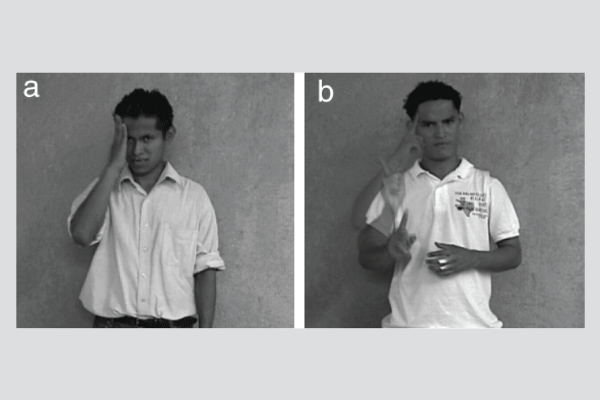Featured
The Social Mind: Language and Other Human Tricks

An estimated 7,000 languages are spoken around the world, each with a unique structure. How information is transmitted through speech can vary tremendously from language to language, which allows experimental psychologists like Lera Boroditsky (University of California, San Diego) to study the myriad ways that language shapes our thinking.
“Language is one of those smart human tricks,” according to Boroditsky. “We can make vibrations with our mouths that can travel through the air and impinge on our eardrums, and then the brain takes that pattern of vibrations and turns it into thoughts.”
Many of the findings in this article were reported in “The Consequences of the Evolution of Language on the Mind,” an integrative science symposium at the 2019 International Convention of Psychological Science (ICPS) in Paris.
Boroditsky’s research on a language called Kuuk Thaayorre—spoken by a remote Aboriginal community in Australia called the Pormpuraaw—provides an example of the way that language can foster cognitive differences between speakers of different languages. Kuuk Thaayorre uses a radically different paradigm to describe and organize space compared to languages like English. There are no words equivalent to “left” or “right”; instead, space is described through words for the cardinal directions, like “north,” “south,” “east,” and “west.”
“So you would say, ‘oh, there’s an ant on your southwest leg’ or ‘move your cup to the northeast,’” Boroditsky explained.
Not only are people who speak languages like Kuuk Thaayorre able to orient themselves in space much better than people who speak languages like English, but these differences in language also open up doors to whole new ways of thinking about relationships between the body, space, and time (Boroditsky & Gaby, 2010).
Different languages also divide up the color spectrum differently. For example, English has one word for “blue,” whereas Russian has distinctive terms for light blues (“goluboy”) and dark blues (“siniy”).
Neuroimaging studies have shown how these features of language begin to influence our experiences at the earliest stages of cognitive processing (Winawer et al., 2007).
“Within the first hundred milliseconds, the brain is already treating color patches as categorically the same or different, depending on whether they would be called by the same name or different names in your language,” Boroditsky said.
A body of research shows that metaphors are another aspect of language that can profoundly shape how we conceptualize experiences.
In a 2018 study, Boroditsky and colleagues found that framing the cancer experience as a “battle” versus a “journey” led to important differences in perceptions about a patient’s situation (Hendricks et al., 2018). Across five experiments, 1,629 participants read otherwise identical vignettes about someone either “battling” cancer or on a “journey” with cancer. When cancer was framed as a battle, readers believed that the patient was more likely to feel guilty about not recovering.
This study is just one example of the ways that even small differences in language can change our emotions and appraisals of major life events, such as the experience of a major illness.
“That’s where language really comes to shine—not just shaping the way we think but actually constructing potentially whole realms of knowledge and thought,” Boroditsky concluded.
Language and the Social Mind
Language also plays a fundamental role in our ability to understand and reason about the social minds of the people around us.
Jennie Pyers (Wellesley College) examines how the emergence of language influences cognition—specifically, how we understand other people’s mental states, an area called “theory of mind.” An advanced component of theory of mind is understanding that someone else can hold erroneous beliefs. For example, a child might realize that a parent will look for a toy where it’s usually kept even if the toy is actually hidden in another location, like under the bed.
“Children struggle with this and don’t really fully understand this until after the age of 4,” Pyers explained. “It seems that their language abilities are a key driving factor in their ability to understand false beliefs.”
Because language skills typically develop around the same time as theory of mind, it is difficult to study whether language facilitates social cognition. To tease apart the development of these skills, Pyers works with children with congenital hearing loss who are born to hearing parents. These children often have some degree of language delay, as their parents do not yet speak sign language and the child’s deafness limits access to the parents’ spoken language.

A Nicaraguan school for deaf children provided Pyers with a unique opportunity to observe how language emerges and influences other areas of development. In Nicaragua, formal schools for deaf children weren’t started until the 1970s. When a school did eventually open, children were finally in a large enough group of other deaf children that they started using their own rudimentary sign language, totally unique to the students at the school. New cohorts of students learned the language (now known as Nicaraguan Sign Language), and it was passed down from one class to the next, gaining complexity over time.
“So these children introduced new vocabulary and more syntactic complexity that, interestingly, the first creators of the language didn’t always learn themselves,” Pyers explained.
“Language, not just social experience, is a prerequisite for the acquisition of false-belief understanding.”
Jennie Pyers (Wellesley College)
Initially, Pyers found that younger students, who had learned a more complex version of the language, performed much better in a false-belief task than the original cohort of deaf students, who had initially learned a less complex version of the language. However, after returning to the field 2 years later, Pyers found that some of the original cohort of signers had improved their theory-of-mind skills along with their language skills.
The findings of her research, published in Psychological Science (Pyers & Senghas, 2009), showed that “language, not just social experience, is a prerequisite for the acquisition of false-belief understanding.”
In a 2020 study with American children who are deaf, Pyers and a team led by Hilary Richardson (Massachusetts Institute of Technology) used fMRI to investigate the neural underpinnings of theory of mind by comparing a group of native-signing children to a group of children whose signing was delayed (Richardson et al., 2020). Neuroimaging findings showed that although brain areas classically associated with theory of mind were activated in both groups, later signing acquisition was associated with less-selective neural responses to information about people’s mental states.
What this tells us is that language is necessary for the specialization of the neural regions associated with theory of mind, Pyers explained. The human brain has evolved to depend on language to reason in sophisticated ways about other people.
Cognition Without Language
Language, whether spoken or signed, plays a foundational role in human cognition, but what can we learn about language from studying animals that lack language? How does cognition develop in the absence of language?
“How can we understand how nonhumans are thinking when they not only don’t have language, but they don’t have the capacity for language like that seen in humans?” mused Alexandra Rosati (University of Michigan), a psychological scientist specializing in comparative cognitive evolution.
Rosati argues that although nonhuman primates may lack language, their behavior provides an opportunity to investigate the roots of complex cognitive processes that have emerged in humans.

“Humans have a long, protracted developmental period with a long period of juvenile brain development that allows us to acquire all these cool cognitive skills that seem to define the human species,” Rosati explained.
Understanding how other primates acquire spatial cognition can help us understand how these skills develop in the absence of language.
As Boroditsky’s research with Kuuk Thaayorre demonstrated, language can influence how we encode spatial references: When people use terms like “right” and “left,” they encode space in an egocentric perspective, whereas people speaking languages like Kuuk Thaayorre might encode spatial information in a more allocentric context, in which a person’s spatial perception is centered on other people and objects.
Comparative developmental studies of nonhumans can help us understand which aspects of human spatial development are shared with other primates, and the extent to which spatial encoding in humans might be dependent on our aptitude for language.
Bonobos, our closest relatives, were able to alternate between self and other centric spatial frameworks in different contexts, suggesting “that language is not necessary to flexibly utilize both types of frameworks” (Rosati, 2015). Similar tests of spatial cognition with lemurs, a much more distant relative, revealed that only one out of four species of lemurs tested (ruffed lemurs) preferentially reasoned using an allocentric framework, whereas the other species were more likely to use an egocentric frame or showed no overall species-level preference.
What this tells us about the origins of human-like cognition is that even without language, primates can still demonstrate humanlike behavior patterns.
Linking Language to Democracy
Although spoken language is estimated to have evolved in humans about 60,000 years ago, written language dates back only about 5,000 years. José Morais and Régine Kolinsky (Université Libre de Bruxelles, Belgium) have spent decades studying how this peculiarly human predilection for literacy has shaped the evolution of language and the mind.
“Evolution is not the only form of change,” Morais said. “Literacy did not ‘evolve’ in the biological sense: It emerged.”
Evidence suggests that literacy isn’t just a useful tool for social cohesion, but that the processes of learning to read fundamentally change the way we process information and perceive the world.
From 1960 to 2015, the global literacy rate for people older than 15 increased from 42% to 86%.
For example, Morais and a team led by APS Fellow Stanislas Dehaene examined brain responses to spoken and written language using fMRI. Participants included groups of adults with varying experiences with literacy: illiterate adults, adults who learned to read later in life, and adults who learned to read during childhood. Results of the study, coauthored by Morais, showed that learning to read as an adult—similar to learning in childhood—led to significant changes in the cortical organization of the brain (Dehaene et al., 2010). Literacy enhanced language-network responses to written and spoken words.
Furthermore, a 2020 paper, coauthored by the same team, found that learning to read at any age was linked to changes in brain connectivity (López-Barroso et al., 2020).
“We must give everybody the cognitive means necessary to a collective critical involvement in important political debates and decisions . . . Critical literacy, in my view, is the key.”
José Morais (Université Libre de Bruxelles, Belgium)
In essence, by becoming literate, we are simultaneously changing our brains and the cognitive frameworks that shape how we interpret the world around us, a concept Morais and Kolinsky calls our “literate glasses.”
“No doubt we are trapped. We are literate, so we can’t think and communicate without using literate concepts,” he argued. “When we put a child in the situation of learning to read, the child’s mind learns and the child’s brain changes at exactly the same time—not before, not later.”
By expressing language through literacy, a new capacity and a new form of mental organization are created. And, Morais said, this capacity for literacy was a necessary condition for the development of philosophy, logic, and science.
Morais argues that it’s essential to consider the equity implications of gaps in global literacy. As of 2015, an estimated 14% of the world’s population over age 15 was illiterate, although Morais believes that data on literacy are often poor quality and this number may well be an underestimation. People living in the world’s poorest countries, particularly women, have the least access to education and, hence, to literacy.
Morais cited global inequities between literacy rates in low-income versus high-income countries as one of the major inequalities among human beings. He described a cycle of “vicious dependency,” whereby so-called democracies require universal literacy from their citizens, which is impossible to achieve in states without a real and functional democracy.
“We must give everybody the cognitive means necessary to a collective critical involvement in important political debates and decisions,” he concluded. “Critical literacy, in my view, is the key.”
References
Boroditsky, L., & Gaby, A. (2010). Remembrances of times east: Absolute spatial representations of time in an Australian Aboriginal community. Psychological Science, 21(11), 1635–1639. https://doi.org/10.1177/0956797610386621
Dehaene, S., Pegado, F., Braga, L. W., Ventura, P., Filho, G. N., Jobert, A., Dehaene-Lambertz, G., Kolinsky, R., Morais, J., & Cohen, L. (2010). How learning to read changes the cortical networks for vision and language. Science, 330(6009), 1359–1364. https://doi.org/10.1126/science.1194140
Hendricks, R. K., Demjén, Z., Semino, E., & Boroditsky, L. (2018). Emotional implications of metaphor: consequences of metaphor framing for mindset about cancer. Metaphor and Symbol, 33(4), 267–279. https://doi.org/10.1080/10926488.2018.1549835
López-Barroso, D., Thiebaut de Schotten, M., Morais, J., Kolinsky, R., Braga, L. W., Guerreiro-Tauil, A., Dehaene, S., & Cohen, L. (2020). Impact of literacy on the functional connectivity of vision and language related networks. NeuroImage, 213, Article 116722. https://doi.org/10.1016/j.neuroimage.2020.116722
Pyers, J. E., & Senghas, A. (2009). Language promotes false-belief understanding: Evidence from learners of a new sign language. Psychological Science, 20(7), 805–812. https://doi.org/10.1111/j.1467-9280.2009.02377.x
Richardson, H., Koster-Hale, J., Caselli, N., Magid, R., Benedict, R., Olson, H., Pyers, J., & Saxe, R. (2020). Reduced neural selectivity for mental states in deaf children with delayed exposure to sign language. Nature Communications, 11(1), 3246. https://doi.org/10.1038/s41467-020-17004-y
Rosati, A. G. (2015). Context influences spatial frames of reference in bonobos (Pan paniscus). Behaviour, 152(3–4), 375–406. https://doi.org/10.1163/1568539X-00003189
Winawer, J., Witthoft, N., Frank, M. C., Wu, L., Wade, A. R., & Boroditsky, L. (2007). Russian blues reveal effects of language on color discrimination. Proceedings of the National Academy of Sciences, 104(19), 7780–7785. https://doi.org/10.1073/pnas.0701644104





APS regularly opens certain online articles for discussion on our website. Effective February 2021, you must be a logged-in APS member to post comments. By posting a comment, you agree to our Community Guidelines and the display of your profile information, including your name and affiliation. Any opinions, findings, conclusions, or recommendations present in article comments are those of the writers and do not necessarily reflect the views of APS or the article’s author. For more information, please see our Community Guidelines.
Please login with your APS account to comment.